Celebrating Fort Myers’ public artworks on International Sculpture Day
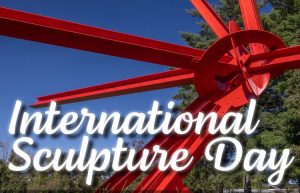 Today is International Sculpture Day. The global celebration draws attention to the art of sculpture and sculpted works and the importance that sculpture plays in creative placemaking.
Today is International Sculpture Day. The global celebration draws attention to the art of sculpture and sculpted works and the importance that sculpture plays in creative placemaking.
While sculpture dates back to the Aurignacian culture that flourished in Europe and southwest Asia at the start of the Upper Paleolithic period, Fort Myers first sculpture dates back 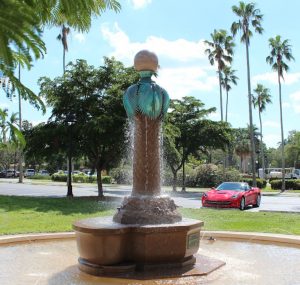 to just August of 1913. That’s when Tootie McGregor’s second husband, Dr. Marshall Terry, installed a fountain in downtown Fort Myers to commemorate her many contributions to our town’s infrastructure (she financed construction of McGregor Boulevard from Whiskey Creek to Punta Rassa out of her own pocket) and recognition as a legitimate tourist destination. The Tootie McGregor Fountain was eventually disassembled and moved to the Fort Myers Country Club to make way for the approach to the
to just August of 1913. That’s when Tootie McGregor’s second husband, Dr. Marshall Terry, installed a fountain in downtown Fort Myers to commemorate her many contributions to our town’s infrastructure (she financed construction of McGregor Boulevard from Whiskey Creek to Punta Rassa out of her own pocket) and recognition as a legitimate tourist destination. The Tootie McGregor Fountain was eventually disassembled and moved to the Fort Myers Country Club to make way for the approach to the 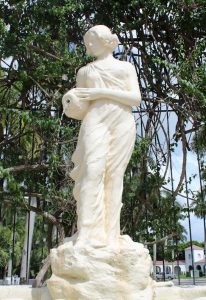 Caloosahatchee Bridge in the 1950s. But you can enjoy it today in the parking lot outside the Edison Restaurant on McGregor Boulevard.
Caloosahatchee Bridge in the 1950s. But you can enjoy it today in the parking lot outside the Edison Restaurant on McGregor Boulevard.
Sadly our second sculpture is currently in a state of disrepair compliments of Hurricane Ian. That artwork is known affectionately by one and all as Rachel at the Well (although her real name is The Spirit of Fort Myers). Ian’s winds toppled the wrought iron fence and bougainvillea behind the Grecian maiden, cracking the poor girl at the neck and waist. We’re all hoping that art experts known as conservators will begin work soon putting the 1926 Helmuth von Zengen masterwork back together again like the proverbial Humpty 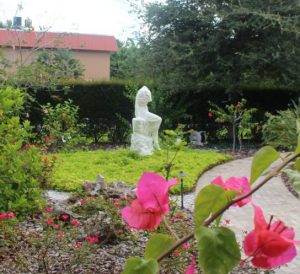 Dumpty.
Dumpty.
Fort Myers got its next sculpture in 1959, when local resident and Fort Myers benefactor Evelyn Rhea devised an 1880 white marble sculpture of a German siren named Lorelei to the local library. Regrettably, vandals decapitated Lorelei in 1997, and the head was never recovered. Today, her headless torso lounges among the flowers at the Fort Myers Lee County Garden Council on Virginia for everyone to enjoy.
It 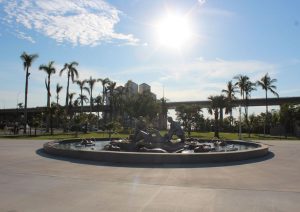 would be another 30 years before the late North Fort Myers sculptor D.J. Wilkins began casting a host of representational sculptures beginning with the Henry Ford Bust in 1985. The next fifteen years would see the “Sculptor of Fort Myers” add landmarks like The Florida Panther (1988), Uncommon Friends (1988), The Great Turtle Chase (2000) and the USCT 2nd Regiment Monument (nicknamed Clayton) (2000)
would be another 30 years before the late North Fort Myers sculptor D.J. Wilkins began casting a host of representational sculptures beginning with the Henry Ford Bust in 1985. The next fifteen years would see the “Sculptor of Fort Myers” add landmarks like The Florida Panther (1988), Uncommon Friends (1988), The Great Turtle Chase (2000) and the USCT 2nd Regiment Monument (nicknamed Clayton) (2000) 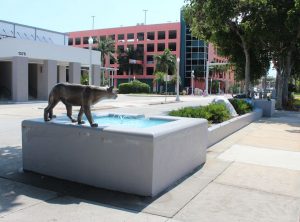 to the Centennial Park landscape. Among his other commissions for the Fort Myers Beautification Advisory Board were The Harborside Collection of busts in 1989 and the Wes Nott Memorial at Lee Memorial Park (2000).
to the Centennial Park landscape. Among his other commissions for the Fort Myers Beautification Advisory Board were The Harborside Collection of busts in 1989 and the Wes Nott Memorial at Lee Memorial Park (2000).
In 2001, Florida Power & Light Co. gave the city Caloosahatchee Manuscripts (the Jim Sanborn light sculpture that 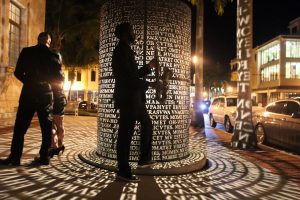 bathes the Sidney & Berne Davis Art Center in illuminated letters after nightfall) to commemorate the conversion of its power plant from oil to natural gas. Today, this luminous art piece lures Art Walkers and Fort Myers Film Festival celebs to the steps of the Davis Art Center like moths to a flame.
bathes the Sidney & Berne Davis Art Center in illuminated letters after nightfall) to commemorate the conversion of its power plant from oil to natural gas. Today, this luminous art piece lures Art Walkers and Fort Myers Film Festival celebs to the steps of the Davis Art Center like moths to a flame.
Fire Dance was 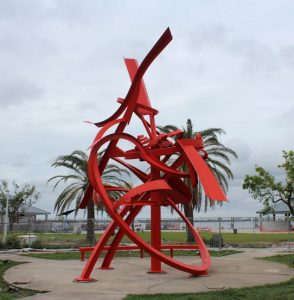 the first public artwork to be commissioned and installed by the Fort Myers Public Art Committee, which was established in 2004. Dedicated March 2, 2012, the red proto-architectural sculpture is the product of internationally-renowned monumental sculptor David Black, who was chosen over 161 other artists who vied for the honor. Black created a modernist piece whose lines, curves and spirals represent the energy and vitality of Centennial Park during public events such as concerts, jazz festivals and Fourth of July fireworks displays.
the first public artwork to be commissioned and installed by the Fort Myers Public Art Committee, which was established in 2004. Dedicated March 2, 2012, the red proto-architectural sculpture is the product of internationally-renowned monumental sculptor David Black, who was chosen over 161 other artists who vied for the honor. Black created a modernist piece whose lines, curves and spirals represent the energy and vitality of Centennial Park during public events such as concerts, jazz festivals and Fourth of July fireworks displays.
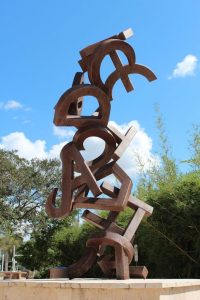 Since Fire Dance‘s dedication, the Public Art Committee has installed just two public art commissions, such as Marks & Brands, an homage to Fort Myers’ origins as a rough-and-tumble cow town during the last third of the 19th century, that graces the courtyard of the new Lee County Library on First and Royal Palm Boulevard, and What Dreams We Have and How They Fly, a mosaic tile sculpture located in Clemente Park that references the complex history and unique accomplishments of the Dunbar community. But in August of 2018, the City purchased a collection of 23 Cor-Ten steel sculptures created by Columbian artist Edgardo Carmona, which can be enjoyed at more than a dozen “art hubs” located throughout the City’s six wards.
Since Fire Dance‘s dedication, the Public Art Committee has installed just two public art commissions, such as Marks & Brands, an homage to Fort Myers’ origins as a rough-and-tumble cow town during the last third of the 19th century, that graces the courtyard of the new Lee County Library on First and Royal Palm Boulevard, and What Dreams We Have and How They Fly, a mosaic tile sculpture located in Clemente Park that references the complex history and unique accomplishments of the Dunbar community. But in August of 2018, the City purchased a collection of 23 Cor-Ten steel sculptures created by Columbian artist Edgardo Carmona, which can be enjoyed at more than a dozen “art hubs” located throughout the City’s six wards.
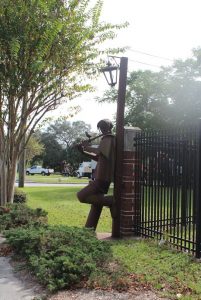 Each of these sculptures has a unique and fascinating story. Some have something to say about our local history while others speak to the location in which they stand. To help you discover and enjoy these stories, the City’s Public Art Committee has subscribed to and uploaded text, photos and audios to a free mobile phone app known as Otocast. Give it a listen. You’ll be so amazed you’ll want to tell your family, friends and co-workers what you’ve learned.
Each of these sculptures has a unique and fascinating story. Some have something to say about our local history while others speak to the location in which they stand. To help you discover and enjoy these stories, the City’s Public Art Committee has subscribed to and uploaded text, photos and audios to a free mobile phone app known as Otocast. Give it a listen. You’ll be so amazed you’ll want to tell your family, friends and co-workers what you’ve learned.
The International Sculpture Day was first established in 2015 by the International Sculpture Center (ISC), a non-profit organization based in the United States. The ISC is committed to promoting and advancing the creation and understanding of sculptures, and this day was initiated to raise awareness about the art of sculpture and encourage people to explore and appreciate its many expressions.














 Tom Hall is both an amateur artist and aspiring novelist who writes art quest thrillers. He is in the final stages of completing his debut novel titled "Art Detective," a story that fictionalizes the discovery of the fabled billion-dollar Impressionist collection of Parisian art dealer Josse Bernheim-Jeune, thought by many to have perished during World War II when the collection's hiding place, Castle de Rastignac in southern France, was destroyed by the Wehrmacht in reprisal for attacks made by members of the Resistance operating in the area. A former tax attorney, Tom holds a bachelor's degree as well as both a juris doctorate and masters of laws in taxation from the University of Florida. Tom lives in Estero, Florida with his fiancee, Connie, and their four cats.
Tom Hall is both an amateur artist and aspiring novelist who writes art quest thrillers. He is in the final stages of completing his debut novel titled "Art Detective," a story that fictionalizes the discovery of the fabled billion-dollar Impressionist collection of Parisian art dealer Josse Bernheim-Jeune, thought by many to have perished during World War II when the collection's hiding place, Castle de Rastignac in southern France, was destroyed by the Wehrmacht in reprisal for attacks made by members of the Resistance operating in the area. A former tax attorney, Tom holds a bachelor's degree as well as both a juris doctorate and masters of laws in taxation from the University of Florida. Tom lives in Estero, Florida with his fiancee, Connie, and their four cats.